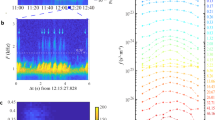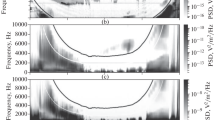Abstract
Whistler mode waves and ECH waves as observed by the THEMIS-D and THEMIS-E satellites have been analyzed. It is observed that ECH waves are very weak for pitch-angle diffusion whereas whistler mode waves are more efficient. Bounce-averaged pitch-angle diffusion rates at the edge of atmospheric loss-cone have been calculated for both waves. Further, these are used to obtain electron precipitation flux inside the loss-cone. The electron flux at the edge of the loss-cone is represented by the kappa distribution. Numerical calculation of precipitation flux is performed by varying the fitting parameters (which determine the shape of electron precipitation flux) appearing in the kappa distribution. Precipitation flux is used to obtain volume excitation rates and height-integrated volume excitation rates for the seven excitation states. Calculations have been performed using two standard atmosphere models corresponding to mean and high solar and geomagnetic activities. It has been observed from studies that the excitation rates produced by the ECH wave are several orders of magnitude smaller than the rates produced by whistler mode waves. We show that the scattering efficiency of whistler Mode is higher than that of ECH waves. The oblique whistler mode waves allow efficient scattering of electrons in diffuse aurora. Outcomes are discussed.












Similar content being viewed by others
Data Availability
THEMIS data used in this study are available to the public through UC Berkeley at http://themis.ssl.berkeley.edu/index.shtml. The datasets generated during and/or analyzed during the current study are available from the corresponding author.
References
Angelopoulos, V., McFadden, J.P., Larson, D., Carlson, C.W., Mende, S.B., Frey, H., et al.: Tail reconnection triggering substorm onset. Science 321, 931–935 (2008). https://doi.org/10.1126/science.1160495
Burtis, W.J., Helliwell, R.A.: Banded chorus a new type of VLF radiation observed in the magnetosphere by OGO 1 and OGO 3. J. Geophys. Res. 74(11), 3002–3010 (1969). https://doi.org/10.1029/ja074i011p03002
Chen, H., Gao, X., Lu, Q., Tsurutani, B.T., Wang, S.: Statistical evidence for EMIC wave excitation driven by substorm injection and enhanced solar wind pressure in the Earth’s magnetosphere: two different EMIC wave sources. Geophys. Res. Lett. 47, e2020GL090275 (2020). https://doi.org/10.1029/2020GL090275
Chen, H., Gao, X., Lu, Q., Sauer, K., Chen, R., Yao, J., Wang, S.: Gap formation around 0.5\(\Omega \)e of whistler-mode waves excited by electron temperature anisotropy. J. Geophys. Res. Space Phys. 126(2), e2020JA028631 (2021). https://doi.org/10.1029/2020JA028631
Chen, H., Gao, X., Lu, Q., Fan, K., Ke, Y., Wang, X., Wang, S.: Gap formation around 0.5\(\Omega \)e in the whistler mode waves due to the plateau-like shape in the parallel electron distribution: 2D PIC simulations. J. Geophys. Res. Space Phys. 127(5), e2021JA030119 (2022). https://doi.org/10.1029/2021JA030119
Chen, H., Chen, R., Gao, X., Lu, Q., Ke, Y., Kong, Z.: Unraveling the role of electron plateau distributions in the power gap formation of chorus waves: Van Allen Probes observations. Geophys. Res. Lett. 50, e2023GL102748 (2023). https://doi.org/10.1029/2023GL102748
Gao, X., Chen, L., Li, W., Lu, Q., Wang, S.: Statistical results of the power gap between lower-band and upper-band chorus waves. Geophys. Res. Lett. 46(8), 4098–4105 (2019). https://doi.org/10.1029/2019GL082140
Gough, M.P., Christiansen, P.J., Martelli, G., Gershuny, E.J.: Interaction of electrostatic waves with warm electrons at geomagnetic equator. Nature 279, 515–517 (1979)
Green, A.E.S., Singhal, R.P.: Microplume model of spatial yield spectra. Geophys. Res. Lett. 6, 625–628 (1979)
Horne, R.B., Thorne, R.M.: Electron pitch angle diffusion by electrostatic electron cyclotron harmonic waves: the origin of pancake distributions. J. Geophys. Res. 105, 5391–5402 (2000). https://doi.org/10.1029/1999JA900447
Horne, R.B., Glauert, S.A., Thorne, R.M.: Resonant diffusion of radiation belt electrons by whistler-mode chorus. Geophys. Res. Lett. 30 (2003). https://doi.org/10.1029/2003GL016963
Jackman, C.H., Garvey, R.H., Green, A.E.S.: Electron impact on atmospheric gases, I. Updated cross-sections. J. Geophys. Res. 82, 5081–5090 (1977). https://doi.org/10.1029/JA082i032p05081
Kasahara, S., Miyoshi, Y., Yokota, S., Mita, T.: Pulsating aurora from electron scattering by chorus waves. Nature 554, 337–340 (2018). https://doi.org/10.1038/nature25505
Kennel, C.F.: Consequences of a magnetospheric plasma. Rev. Geophys. 7, 379 (1969)
Kennel, C.F., Petschek, H.E.: Limit on stably trapped particle fluxes. J. Geophys. Res. 71, 1 (1966)
Kepko, L., Spanswick, E., Angelopoulos, V., Donovan, E., McFadden, J., Glassmeier, K.-H., et al.: Equatorward moving auroral signatures of a flow burst observed prior to auroral onset. Geophys. Res. Lett. 36, L24104 (2009). https://doi.org/10.1029/2009GL041476
Khotyaintsev, Y.V., Cully, C., Vaivads, A., André, M., Owen, C.: Plasma jet braking: Energy dissipation and nonadiabatic electrons. Phys. Rev. Lett. 106(16) (2011). https://doi.org/10.1103/PhysRevLett.106.165001
Li, W., Bortnik, J., Thorne, R.M., Angelopoulos, V.: Global distribution of wave amplitudes and wave normal angles of chorus waves using THEMIS wave observations. J. Geophys. Res. 116(A12), A12205 (2011). https://doi.org/10.1029/2011JA017035
Li, W., Ma, Q., Shen, X.-C., Zhang, X.-J., Mauk, B.H., Clark, G., et al.: Quantification of diffuse auroral electron precipitation driven by whistler mode waves at Jupiter. Geophys. Res. Lett. 48, e2021GL095457 (2021). https://doi.org/10.1029/2021GL095457
Liang, J., Uritsky, V., Donovan, E., Ni, B., Spanswick, E., Trondsen, T., et al.: THEMIS observations of electron cyclotron harmonic emissions, ULF waves, and pulsating auroras. J. Geophys. Res. 115, A10235 (2010). https://doi.org/10.1029/2009JA015148
Liou, K., Meng, C.-I., Newell, P.T., Lui, A.T.Y., Reeves, G.D., Belian, R.D.: Particle injections with auroral expansions. J. Geophys. Res. 106(A4), 5873–5881 (2001). https://doi.org/10.1029/2000ja003003
Lopez, R.E., Sibeck, D.G., McEntire, R.W., Krimigis, S.M.: The energetic ion substorm injection boundary. J. Geophys. Res. 95(A1), 109–117 (1990). https://doi.org/10.1029/ja095ia01p00109
Lyons, L.R.: Electron diffusion driven by magnetospheric electrostatic waves. J. Geophys. Res. 79, 575–580 (1974a)
Lyons, L.R.: Pitch angle and energy diffusion coefficients from resonant interactions with ion-cyclotron and whistler waves. J. Plasma Phys. 12, 417–432 (1974b)
Ma, J., Gao, X., Chen, H., Tsurutani, B.T., Ke, Y., Chen, R., Lu, Q.: The effects of substorm injection of energetic electrons and enhanced solar wind ram pressure on whistler-mode chorus waves: a statistical study. J. Geophys. Res. 127(11) (2022). https://doi.org/10.1029/2022JA030502
Meng, C.-I., Mauk, B., McIlwain, C.E.: Electron precipitation of evening diffuse aurora and its conjugate electron fluxes near the magnetospheric equator. J. Geophys. Res. 84, 2545–2558 (1979). https://doi.org/10.1029/JA084iA06p02545
Meredith, N.P., Johnstone, A.D., Szita, S., Horne, R.B., Anderson, R.R.: “Pancake” electron distributions in the outer radiation belts. J. Geophys. Res. 104, 12431–12444 (1999). https://doi.org/10.1029/1998JA900083
Meredith, N.P., Horne, R.B., Thorne, R.M., Anderson, R.R.: Survey of upper band chorus and ECH waves: implications for the diffuse aurora. J. Geophys. Res. 114, A07218 (2009). https://doi.org/10.1029/2009JA01423
Newell, P.T., Sotirelis, T., Wing, S.: Diffuse monoenergetic, and broadband aurora: the global precipitation budget. J. Geophys. Res. 114, A09207 (2009). https://doi.org/10.1029/2009JA014326
Newell, P.T., Sotirelis, T., Wing, S.: Seasonal variations in diffuse, monoenergetic, and broadband aurora. J. Geophys. Res. 115, A03216 (2010). https://doi.org/10.1029/2009JA014805
Ni, B., Thorne, R.M., Shprits, Y.Y., Bortnik, J.: Resonant scattering of plasma sheet electrons by whistler-mode chorus: contribution to diffuse auroral precipitation. Geophys. Res. Lett. 35, L11106 (2008). https://doi.org/10.1029/2008GL034032
Ni, B., Thorne, R.M., Horne, R.B., Meredith, N.P., et al.: Resonant scattering of plasma sheet electrons leading to diffuse auroral precipitation: 1. Evaluation for electrostatic electron cyclotron harmonic waves. J. Geophys. Res. 116, A04218 (2011a). https://doi.org/10.1029/2010JA016232
Ni, B., Thorne, R., Liang, J., Angelopoulos, V., Cully, C., Li, W., et al.: Global distribution of electrostatic electron cyclotron harmonicwaves observed on THEMIS. J. Geophys. Res. 38, L17105 (2011c). https://doi.org/10.1029/2011GL048793
Ni, B., Thorne, R.M., Meredith, N.P., Horne, R.B., Shprits, Y.Y.: Resonant scattering of plasma sheet electrons leading to diffuseauroral precipitation: 2. Evaluation for whistler mode chorus waves. J. Geophys. Res. 116, A04219 (2011b). https://doi.org/10.1029/2010JA016233
Ni, B., Liang, J., Thorne, R.M., Angelopoulos, V., Horne, R.B., Kubyshkina, M., Spanswick, E., Donovan, E.F., Lummerzheim, D.: Efficient diffuse auroral electron scattering by electrostatic electron cyclotron harmonic waves in the outer magnetosphere: a detailed case study. J. Geophys. Res. 117, A01218 (2012). https://doi.org/10.1029/2011JA017095
Ni, B., et al.: Origins of the Earth’s diffuse auroral precipitation. Space Sci. Rev. 200, 205–259 (2016). https://doi.org/10.1007/s11214-016-0234-7
Orlova, K.G., Shprits, Y.Y.: On the bounce-averaged of scattering rates and the calculations of bounce period. Phys. Plasmas 18, 092904 (2011). https://doi.org/10.1063/1.3638137
Rees, M.H., Roble, R.G.: Excitation of the O(1D) atoms in aurorae and emission of the [OI] 6300-A° line. Can. J. Phys. 64(12), 1608–1613 (1986). https://doi.org/10.1139/p86-284
Schumaker, T.L., Gussenhoven, M.S., Hardy, D.A., Carovillano, R.L.: The relationship between diffuse auroral and plasma sheet electron distributions near local midnight. J. Geophys. Res. 94, 10061–10078 (1989). https://doi.org/10.1029/JA094iA08p10061
Singhal, R.P., Green, A.E.S.: Spatial aspects of electron energy degradation in atomic oxygen. J. Geophys. Res. 86, 4776–4780 (1981)
Singhal, R.P., Tripathi, A.K.: Study of whistler mode instability in Saturn’s magnetosphere. Ann. Geophys. 24, 1705–1712 (2006)
Singhal, R.P., Jackman, C.H., Green, A.E.S.: Spatial aspects of low-and medium energy electron degradation in N2. J. Geophys. Res. 85, 1246–1254 (1980)
Thorne, R.M., Ni, B., Tao, X., Horne, R.B., Meredith, N.P.: Scattering by chorus waves as the dominant cause of diffuse auroral precipitation. Nature 467(7318), 943–946 (2010). https://doi.org/10.1038/nature09467
Tripathi, A.K., Singhal, R.P.: Diffusion coefficients from resonant interactions with electrostatic electron cyclotron harmonic waves. Phys. Plasmas 16 (2009). https://doi.org/10.10163/1.3264735
Tripathi, A.K., Singhal, R.P., Singh, K.P., Singh, O.N. II: Diffuse auroral precipitation by resonant interaction with electron cyclotron harmonic and whistler mode waves. J. Atmos. Sol.-Terr. Phys. 97, 125–134 (2013). https://doi.org/10.1016/j.jastp.2013.01.013
Tripathi, A.K., Singhal, R.P., Singh, O.N. II: The generation of Ganymede’s diffuse aurora through pitch angle scattering. Ann. Geophys. 35, 239–252 (2017). https://doi.org/10.5194/angeo-35-239-2017
Tripathi, A.K., Singhal, R.P., Singh, O.N. II: The generation of Saturn’s aurora at lower latitudes by electrostatic waves. J. Geophys. Res. Space Phys. 123 (2018). https://doi.org/10.1002/2017JA024804
Tsurutani, B.T., Smith, E.J.: Postmidnight chorus: a substorm phenomenon. J. Geophys. Res. 79(1), 118–127 (1974). https://doi.org/10.1029/JA079i001p00118
Wendel, D.E., Khazanov, G.V., Tripathi, A.K., Singhal, R.P., Zesta, E.: Source of the bursty bulk flow diffuse aurora: electrostatic cyclotron harmonic and whistler waves in the coupling of bursty bulk flows to auroral precipitation. J. Geophys. Res. 124, 6669–6690 (2019). https://doi.org/10.1029/2019JA026606
Zhang, X.J., Angelopoulos, V., Ni, B., Thorne, R.M.: Predominance of ECH wave contribution to diffuse aurora in Earth’s outer magnetosphere. J. Geophys. Res. Space Phys. 120, 295–309 (2015). https://doi.org/10.1002/2014JA020455
Zhang, X.-J., Chen, L., Artemyev, A.V., Angelopoulos, V., Liu, X.: Periodic excitation of chorus and ECH waves modulated by ultralow frequency compressions. J. Geophys. Res. Space Phys. 124, 8535–8550 (2019). https://doi.org/10.1029/2019JA027201
Zhima, Z., Cao, J., Fu, H., Liu, W., Chen, L., Dunlop, M., Zhang, X.M.: Whistler mode wave generation at the edges of a magnetic dip. J. Geophys. Res. Space Phys. 120, 2469–2476 (2015). https://doi.org/10.1002/2014JA020786
Acknowledgements
This work is carried out with the collaboration of Indian Space Research Organization (ISRO), Bangalore, India. Computer facilities provided by IIT (BHU) and Dr. A.K. Pandey from BHU are highly recognized for the calculations reported in the present work.
Funding
Dr D. Wendel was supported by NASA grant N NH 14ZDA 001N- HSR.
Author information
Authors and Affiliations
Contributions
All authors have done worked together and reviewed the manuscript.
Corresponding author
Ethics declarations
Competing interests
The authors declare no competing interests.
Additional information
Publisher’s Note
Springer Nature remains neutral with regard to jurisdictional claims in published maps and institutional affiliations.
Rights and permissions
Springer Nature or its licensor (e.g. a society or other partner) holds exclusive rights to this article under a publishing agreement with the author(s) or other rightsholder(s); author self-archiving of the accepted manuscript version of this article is solely governed by the terms of such publishing agreement and applicable law.
About this article
Cite this article
Tripathi, A.K., Singhal, R.P. & Wendel, D.E. Diffuse auroral intensities produced by whistler mode and electron cyclotron harmonic waves. Astrophys Space Sci 368, 61 (2023). https://doi.org/10.1007/s10509-023-04217-y
Received:
Accepted:
Published:
DOI: https://doi.org/10.1007/s10509-023-04217-y




